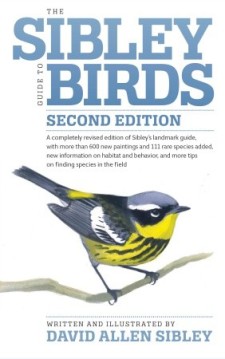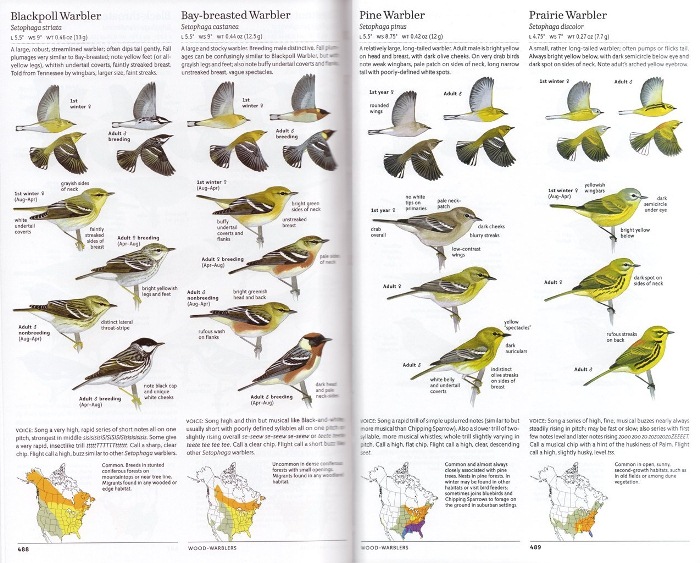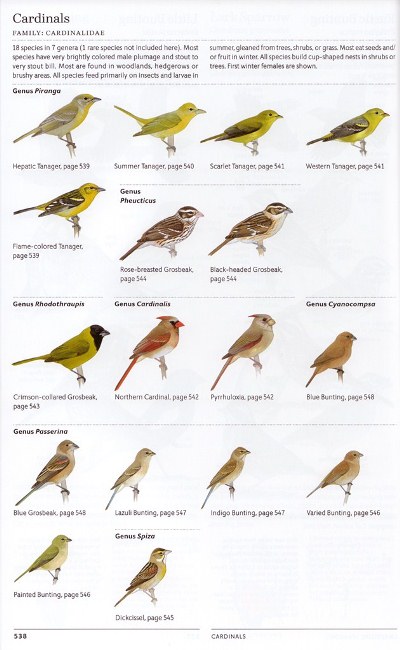Reviewed by Grant McCreary on February 15th, 2015.
Note: This review is of the second printing. (The significance of that will be explained.)
The Sibley Guide (published in Europe as The North American Bird Guide) has been my constant companion – whether printed or as an app –since I started birding. Let me just come out and say it: it’s the best North American field guide, and this second edition has made it even better. I don’t know if I can do it justice, but I’ll try to explain what makes The Sibley Guide to Birds (Second Edition) so special.
Layout
This new edition of The Sibley Guide includes 923 birds – all of the regularly occurring species in North America (excluding Hawaii, Bermuda, and Greenland), as well as many rare visitors and introduced exotics. It’s a big book; if you want to carry it in the field you’ll need a bag or backpack. But it puts the space to extraordinarily good use, fitting in tons of illustrations and a surprising amount of text in a way that facilitates comparison between species.
The accounts are laid out vertically, with the illustrations taking up most of the real estate in the middle of the page, framed by text above and below. Most birds get half a page, many a full page, and a few more or less than that. The best part is that the illustrations are organized in a consistent manner, with the bird in flight at the top, followed down the page by the juvenile and then female and male adults in nonbreeding and breeding plumage, where appropriate. This, combined with the fact that all the illustrations are oriented in the same direction (with the bird facing right), allows very easy comparison. For example, with a quick look across the page you can compare the very similar first-year Blackpoll, Bay-breasted, Pine, and Prairie Warblers without hunting around the page for the matching illustrations.
Illustrations
Sibley’s paintings, in my opinion, are not only the most accurate representation of North American birds, but the most aesthetically pleasing as well. They simply look great! And the format of the book allows for the paintings to be reproduced at a relatively large size, enhancing their usefulness (they are even 15-20% larger than in the first edition).
There are many things that I like about The Sibley Guide, but foremost among them is the sheer number of illustrations. One of the most important features of a primary field guide is that it show, as much as possible, every variation that you’re likely to see. For most birds, one, or even two, illustrations aren’t enough. And when you start talking about extremely variable birds, such as gulls and Red-tailed Hawks, you may need a dozen or more. On average, Sibley includes more illustrations per species than any other North American field guide (although you could argue for The Crossley ID Guide, and the Stokes guide is close).
Just about every identifiable plumage that birders are likely to encounter is included. The only major exception is nestlings and fledglings still dependent on their parents; very few of these are shown. Regional variation is highlighted, which could prove very useful in the case of splits. Uniquely (as far as I’m aware), aside from a few very rare vagrants, every bird is shown in flight. And not just once, but at least twice so that both the upper and under-side can be shown.
The illustrations are captioned with the age, sex, and condition, as appropriate: “Juvenile”, “1st winter”, “Drabber adult”, “Adult male breeding”, etc. Additionally, Sibley includes the approximate months in which you’d see plumages held only during certain times of the year. This is less useful the more experience you have as a birder, but when I was first starting out it was incredibly useful to me. It made it obvious that, as I started birding in the fall, I shouldn’t be looking for a bright red Scarlet Tanager (which was incredibly disappointing). Amazingly, The Sibley Guide is the only field guide I know that includes this.
Text and Range Maps
The first text any user of The Sibley Guide is likely to read is the annotations surrounding the illustrations. They point out field marks that are especially useful in identifying the bird. You definitely want to pay attention to them, but don’t ignore the rest of the text. At the top of the account is a short description of the bird, to be used in conjunction with the annotations. Below the illustrations is a description of the voice, including songs and calls. This section is more extensive than most field guides. Finally, at the bottom of the page a block of text next to the range map gives information on abundance and habitats, as well as additional details on behavior, variation, and other things as appropriate. (If you’re familiar with the Sibley regional guides, this text has largely been adapted from them.)
Interspersed among the species accounts are 69 sidebars that present a great deal of supplemental, but very useful and relevant, information. For the most part they cover topics related to identification, such as Molt in Seabirds, Identification of Hybrid Gulls, and Identification of Empidonax. Some, like Domestic Geese, Domestic Ducks, and Exotic Waterfowl are miniature species accounts – with an illustration and brief text for several species. And still other sidebars deal with birding directly (i.e. Owling) or indirectly (Bird Families).
One surefire way to become a better birder is to read The Sibley Guide cover to cover. I’ve never done that with a field guide, but I plan to do that with this one.
All but the rarest vagrants have a range map, with distinct colors for year-round, summer, winter, migration, and “rare”. Two nice things about the maps is that they include political boundaries and if a bird has a limited range the map is “zoomed in” so that you can see that range more clearly. However, the maps are pretty small relative to the page size. It’s almost impossible to make out details in the smaller New England states, for example. More aggressive zooming would have helped; many maps still show huge swaths of land (mostly Alaska and northern Canada) where the bird doesn’t occur.
Introduction
The introduction includes topics that are now expected, such as topography (seven pages of diagrams!) and keys to the species accounts and range maps. It also has relatively extensive sections on bird classification, variation, and molt (including a very helpful chart on the molt cycle of a typical passerine). Birders, especially newer ones, would be well advised to read the entire introduction. One thing I was very happy to see is a full page illustrating the extinct species and subspecies of North America.
Each family or group of related species has its own introduction that summarizes their common characteristics. All the members of the group, except the very rare, are depicted together, allowing for easy comparison. The immature or female plumage is shown because “these present the greatest identification challenge.” This will be useful as a visual index (as the page number for each species is included) for those who have narrowed a mystery bird down to a family, but, to be honest, I’ve never used this feature much.
Changes from First Edition
This second edition, at first glance, doesn’t look all that different from the first. But there are some significant differences. I go into detail on these in my Initial Review. In summary, these changes have only improved the guide, and make it worth having even if you own the first edition.
Issues and Controversy
When this edition was published in March 2014, there was a small controversy over the colors of the illustrations. Many paintings, especially the red ones, were too dark. Many reviewers (myself included) pointed to the Scarlet Tanager as the most obvious example. It obviously did not look like the radiantly red bird that we all love. But there were many other examples that would be even more confusing to newer birders (see my Initial Review for more details). Another problem is that the text was very light, making it difficult for many to read.
After a little initial uncertainty, it was announced that a second printing would be forthcoming to correct these issues, and about seven months later they started showing up. The colors looked much better, and the text was darkened. Some other issues, such as missing and incorrect labels, were also corrected. This was great, but what about those who bought the first printing? I reported an apparent replacement program from the publisher, but even though some did in fact receive replacements, it seems this was not an official policy. As of right now, the best course of action if you have the first printing is to seek a replacement from wherever you purchased it (Amazon has been great with this). If that doesn’t work, then call the publisher.
Even though the second printing is much better, it still has a few minor issues. The cormorant silhouettes on page 97 don’t have the annotations that were present in the first edition. Also, the Spruce Grouse account discusses the differences between the two forms (Franklin’s and “Taiga”), but does not give a good indication of where each is found, whereas the first edition did. I’m sure there are other, similar issues, but none are major enough to prevent the recommendation of this book (unlike the colors in the first printing).
Recommendation
The Sibley Guide to Birds (Second Edition) is the best field guide to North American birds. The combination of excellent design, artwork, and text is unparalleled. Anyone birding in the United States or Canada should have this guide, and so too should birders in Europe, the Caribbean, Central America, and anywhere else you may encounter any of the birds contained within.
Please note that the content of the second edition is only available in this “big guide” right now; the smaller Eastern and Western guides and the app have not been updated yet. But even if you use one of those in the field, you should have this larger one for a reference.






This review was very helpful in helping me identify the second printing, and learn about the advantages of this field guide.
Glad to hear that, Gene.
This review and the 2nd edition are enough to know I will be purchasing the new edition. 🙂
make sure the pictures show up in the e-book vreoisn. if you could make it an ebook to be sold in the app store like a comic book/novel that would be really cool and i bet a lot of people would buy it.
I just bought the second printing of the second edition and I am enthralled. Previously working off of the Western Guide and can’t be happier with my choice of getting the full guide this time. Thanks!
[…] The Sibley Guide to Birds (Second Edition) February 15th, 2015 Grant McCreary (The Birder’s Library) […]
[…] online and they all have very positive opinions about it. You can read a detailed description in The Birder’s Library and on the 10,000birds.com pages, from which I partly drew inspiration for this […]